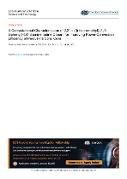A Computational Characterization of 2,2'-bis(trifluoromethyl)-[1,1'-biphenyl]-4,4'-diamine Iodine Dopant for Improving Power-Conversion Efficiency of Perovskite Solar Cells

Publication date
2022Published in
ECS Journal of Solid State Science and TechnologyVolume / Issue
11 (11)ISBN / ISSN
ISSN: 2162-8769Metadata
Show full item recordCollections
This publication has a published version with DOI 10.1149/2162-8777/ac9d2a
Abstract
The paper presents ongoing density-functional theory (DFT) computational support to research of hybrid perovskite solar cells to facilitate their understanding at molecular level. Very recently, doping by a iodine salt, namely 2,2'-bis(trifluoromethyl)-[1,1'-biphenyl]-4,4'-diamine iodine BFBAI(2), has been described that improves the power conversion efficiency and enhances device stability. As structural characteristics of BFBAI(2) are not well known, they are supplied here through DFT calculations for both BFBAI(2) monomer and dimer. The geometry optimizations are performed at the M06-2X/3-21G level, and energetics is refined with the M06-2X/Def2QZVP treatment. The dimerization potential-energy change is calculated as -6.2 kcal/mol. BFBAI(2) exhibits highly non-uniform charge distribution, i.e., it is a clearly polar system that can strongly modulate surface conditions when adsorbed. The adsorption-energy gain for BFBAI(2) on CsPbI3 perovskite is DFT evaluated as -13.2 kcal/mol.
Keywords
optoelectronics, chemical properties of optoelectronic materials, Theory and Modelling, Electron Devices, Energy Conversion-Photovoltaics
Permanent link
https://hdl.handle.net/20.500.14178/1813License
Full text of this result is licensed under: Creative Commons Uveďte původ-Neužívejte dílo komerčně-Nezpracovávejte 4.0 International






